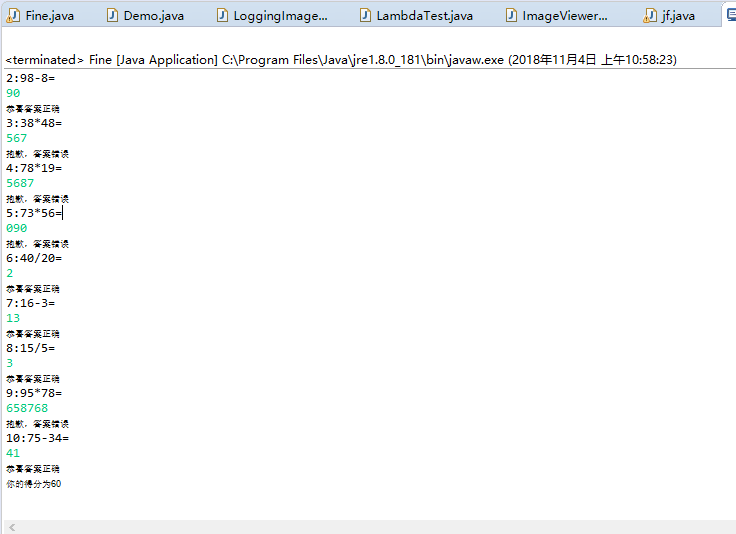实验十 泛型程序设计技术
实验时间 2018-11-1
1、实验目的与要求
(1) 理解泛型概念;
(2) 掌握泛型类的定义与使用;
(3) 掌握泛型方法的声明与使用;
(4) 掌握泛型接口的定义与实现;
(5)了解泛型程序设计,理解其用途。
2、实验内容和步骤
实验1: 导入第8章示例程序,测试程序并进行代码注释。
测试程序1:
l 编辑、调试、运行教材311、312页 代码,结合程序运行结果理解程序;
l 在泛型类定义及使用代码处添加注释;
l 掌握泛型类的定义及使用。
1 package pair1; 2 3 /** 4 * @version 1.00 2004-05-10 5 * @author Cay Horstmann 6 */ 7 public class Pair<T> //Pair引入一个类型变量T 8 { 9 //类定义中的类型变量指定方法的返回类型以及域和局部变量的类型 10 private T first; 11 private T second; 12 13 public Pair() { first = null; second = null; } 14 public Pair(T first, T second) { this.first = first; this.second = second; } 15 16 public T getFirst() { return first; } 17 public T getSecond() { return second; } 18 19 public void setFirst(T newValue) { first = newValue; } 20 public void setSecond(T newValue) { second = newValue; } 21 }
1 package pair1; 2 3 /** 4 * @version 1.01 2012-01-26 5 * @author Cay Horstmann 6 */ 7 public class PairTest1 8 { 9 public static void main(String[] args) 10 { 11 String[] words = { "Mary", "had", "a", "little", "lamb" }; 12 Pair<String> mm = ArrayAlg.minmax(words);//mm保存minmax对象的返回值 13 System.out.println("min = " + mm.getFirst()); 14 System.out.println("max = " + mm.getSecond()); 15 } 16 } 17 18 class ArrayAlg 19 { 20 /** 21 * Gets the minimum and maximum of an array of strings. 22 * @param a an array of strings 23 * @return a pair with the min and max value, or null if a is null or empty 24 *///版权、参数声明 25 public static Pair<String> minmax(String[] a)//用具体的类型替换类型变量实例化泛型类型 26 { 27 if (a == null || a.length == 0) return null; 28 String min = a[0]; 29 String max = a[0]; 30 for (int i = 1; i < a.length; i++)//a.length指数组的属性值 31 { 32 if (min.compareTo(a[i]) > 0) min = a[i];//比较同时保存最大值和最小值 33 if (max.compareTo(a[i]) < 0) max = a[i];//compareTo方法可实现字符串比较 34 } 35 return new Pair<>(min, max);//返回Pair<>带参数的构造器 36 } 37 }
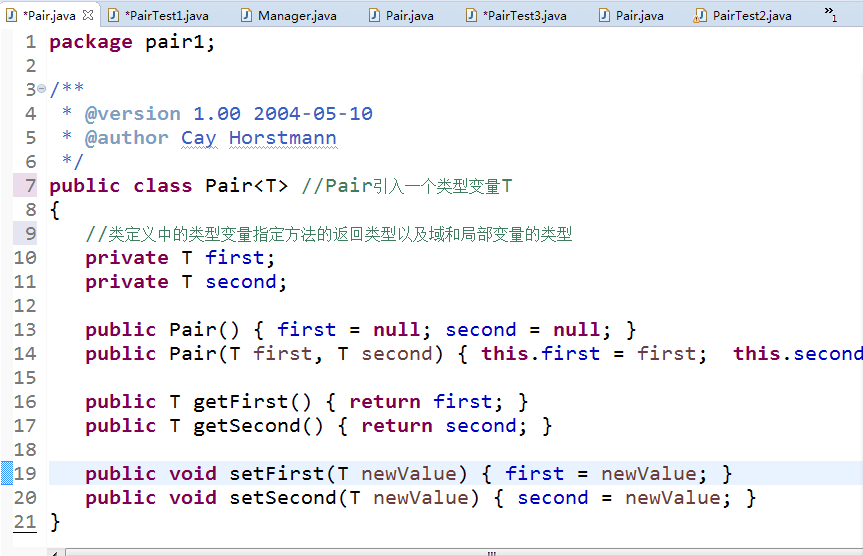


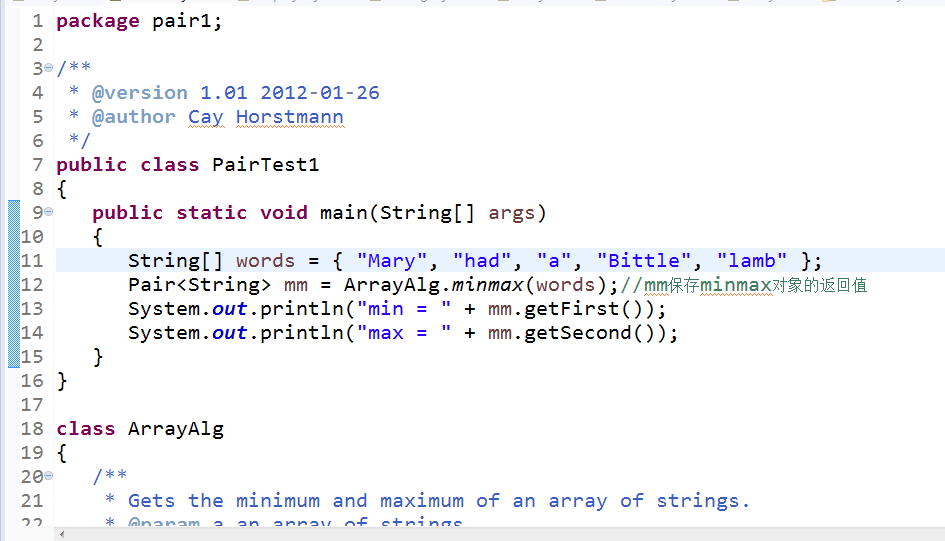

测试程序2:
l 编辑、调试运行教材315页 PairTest2,结合程序运行结果理解程序;
l 在泛型程序设计代码处添加相关注释;
l 掌握泛型方法、泛型变量限定的定义及用途。
1 package pair2; 2 3 /** 4 * @version 1.00 2004-05-10 5 * @author Cay Horstmann 6 */ 7 public class Pair<T> //Pair引入一个类型变量T 8 { 9 //类定义中的类型变量指定方法的返回类型以及域和局部变量的类型 10 private T first; 11 private T second; 12 13 public Pair() { first = null; second = null; } 14 public Pair(T first, T second) { this.first = first; this.second = second; } 15 16 public T getFirst() { return first; } 17 public T getSecond() { return second; } 18 19 public void setFirst(T newValue) { first = newValue; } 20 public void setSecond(T newValue) { second = newValue; } 21 }
1 package pair2; 2 3 import java.time.*; 4 5 /** 6 * @version 1.02 2015-06-21 7 * @author Cay Horstmann 8 */ 9 public class PairTest2 10 { 11 public static void main(String[] args) 12 { 13 LocalDate[] birthdays = 14 { 15 LocalDate.of(1906, 12, 9), // G. Hopper 16 LocalDate.of(1815, 12, 10), // A. Lovelace 17 LocalDate.of(1903, 12, 3), // J. von Neumann 18 LocalDate.of(1910, 6, 22), // K. Zuse 19 }; 20 Pair<LocalDate> mm = ArrayAlg.minmax(birthdays);//mm保存minmax对象的返回值 21 System.out.println("min = " + mm.getFirst()); 22 System.out.println("max = " + mm.getSecond()); 23 } 24 } 25 26 class ArrayAlg 27 { 28 /** 29 Gets the minimum and maximum of an array of objects of type T. 30 @param a an array of objects of type T 31 @return a pair with the min and max value, or null if a is 32 null or empty 33 */ 34 //将T限制为实现了Comparable接口的类。 定义泛型变量的上界(泛型方法) 35 public static <T extends Comparable> Pair<T> minmax(T[] a) 36 { 37 if (a == null || a.length == 0) return null; 38 T min = a[0]; 39 T max = a[0]; 40 for (int i = 1; i < a.length; i++) 41 { 42 if (min.compareTo(a[i]) > 0) min = a[i]; 43 if (max.compareTo(a[i]) < 0) max = a[i]; 44 } 45 return new Pair<>(min, max);//返回Pair<>带参数的构造器 46 } 47 }
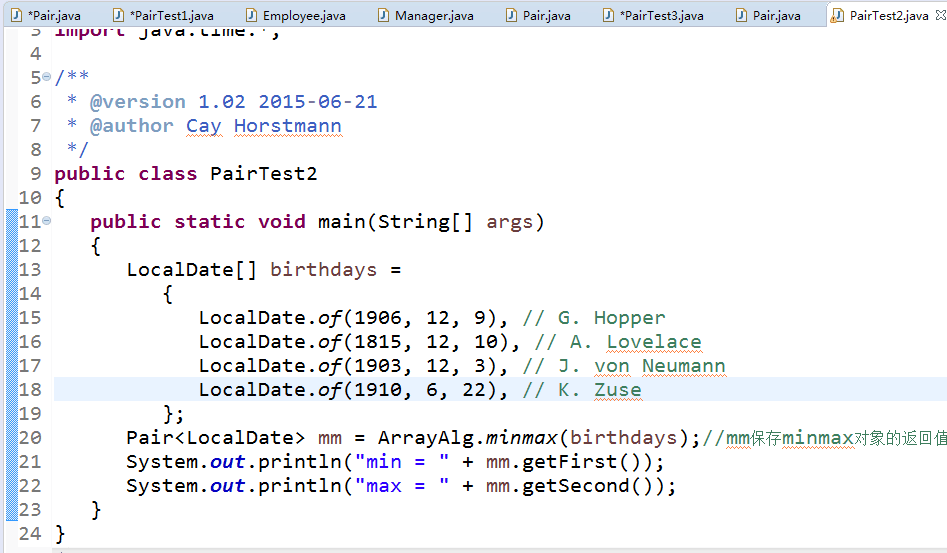

测试程序3:
l 用调试运行教材335页 PairTest3,结合程序运行结果理解程序;
l 了解通配符类型的定义及用途。
1 package pair3; 2 3 import java.time.*; 4 5 public class Employee 6 { 7 private String name; 8 private double salary; 9 private LocalDate hireDay; 10 11 public Employee(String name, double salary, int year, int month, int day) 12 { 13 this.name = name; 14 this.salary = salary; 15 hireDay = LocalDate.of(year, month, day); 16 } 17 18 public String getName() 19 { 20 return name; 21 } 22 23 public double getSalary() 24 { 25 return salary; 26 } 27 28 public LocalDate getHireDay() 29 { 30 return hireDay; 31 } 32 33 public void raiseSalary(double byPercent) 34 { 35 double raise = salary * byPercent / 100; 36 salary += raise; 37 } 38 }
1 package pair3; 2 3 import pair3.Employee; 4 5 public class Manager extends Employee 6 { 7 private double bonus; 8 9 /** 10 @param name the employee's name 11 @param salary the salary 12 @param year the hire year 13 @param month the hire month 14 @param day the hire day 15 */ 16 public Manager(String name, double salary, int year, int month, int day) 17 { 18 super(name, salary, year, month, day); 19 bonus = 0; 20 } 21 22 public double getSalary() 23 { 24 double baseSalary = super.getSalary(); 25 return baseSalary + bonus; 26 } 27 28 public void setBonus(double b) 29 { 30 bonus = b; 31 } 32 33 public double getBonus() 34 { 35 return bonus; 36 } 37 }
1 package pair3; 2 3 /** 4 * @version 1.00 2004-05-10 5 * @author Cay Horstmann 6 */ 7 public class Pair<T> //Pair引入一个类型变量T 8 { 9 //类定义中的类型变量指定方法的返回类型以及域和局部变量的类型 10 private T first; 11 private T second; 12 13 public Pair() { first = null; second = null; } 14 public Pair(T first, T second) { this.first = first; this.second = second; } 15 16 public T getFirst() { return first; } 17 public T getSecond() { return second; } 18 19 public void setFirst(T newValue) { first = newValue; } 20 public void setSecond(T newValue) { second = newValue; } 21 }
1 package pair3; 2 3 /** 4 * @version 1.01 2012-01-26 5 * @author Cay Horstmann 6 */ 7 public class PairTest3 8 { 9 public static void main(String[] args) 10 { 11 Manager ceo = new Manager("Gus Greedy", 800000, 2003, 12, 15); 12 Manager cfo = new Manager("Sid Sneaky", 600000, 2003, 12, 15); 13 Pair<Manager> buddies = new Pair<>(ceo, cfo); 14 printBuddies(buddies); 15 16 ceo.setBonus(1000000); 17 cfo.setBonus(500000); 18 Manager[] managers = { ceo, cfo }; 19 20 Pair<Employee> result = new Pair<>(); 21 minmaxBonus(managers, result); 22 System.out.println("first: " + result.getFirst().getName() 23 + ", second: " + result.getSecond().getName()); 24 maxminBonus(managers, result); 25 System.out.println("first: " + result.getFirst().getName() 26 + ", second: " + result.getSecond().getName()); 27 } 28 29 //定义泛型变量的下界 。 30 public static void printBuddies(Pair<? extends Employee> p) 31 { 32 Employee first = p.getFirst(); 33 Employee second = p.getSecond(); 34 System.out.println(first.getName() + " and " + second.getName() + " are buddies."); 35 } 36 37 //定义泛型变量的下界 。 38 public static void minmaxBonus(Manager[] a, Pair<? super Manager> result) 39 { 40 if (a.length == 0) return; 41 Manager min = a[0]; 42 Manager max = a[0]; 43 for (int i = 1; i < a.length; i++) 44 { 45 if (min.getBonus() > a[i].getBonus()) min = a[i]; 46 if (max.getBonus() < a[i].getBonus()) max = a[i]; 47 } 48 result.setFirst(min); 49 result.setSecond(max); 50 } 51 52 //定义泛型变量的下界 。 “?"为下限通配符。 53 public static void maxminBonus(Manager[] a, Pair<? super Manager> result) 54 { 55 minmaxBonus(a, result); 56 PairAlg.swapHelper(result); //OK——swapHelper捕获通配符类型 57 } 58 // 无法写入公共静态<T super manager> ... 59 } 60 61 class PairAlg 62 { 63 public static boolean hasNulls(Pair<?> p) 64 { 65 return p.getFirst() == null || p.getSecond() == null; 66 } 67 68 public static void swap(Pair<?> p) { swapHelper(p); } 69 70 public static <T> void swapHelper(Pair<T> p) 71 { 72 T t = p.getFirst(); 73 p.setFirst(p.getSecond()); 74 p.setSecond(t); 75 } 76 }
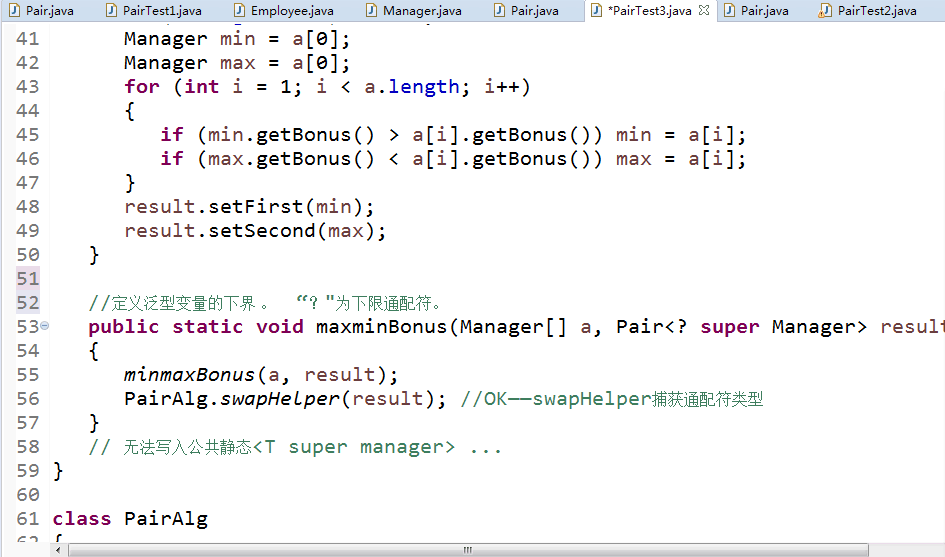


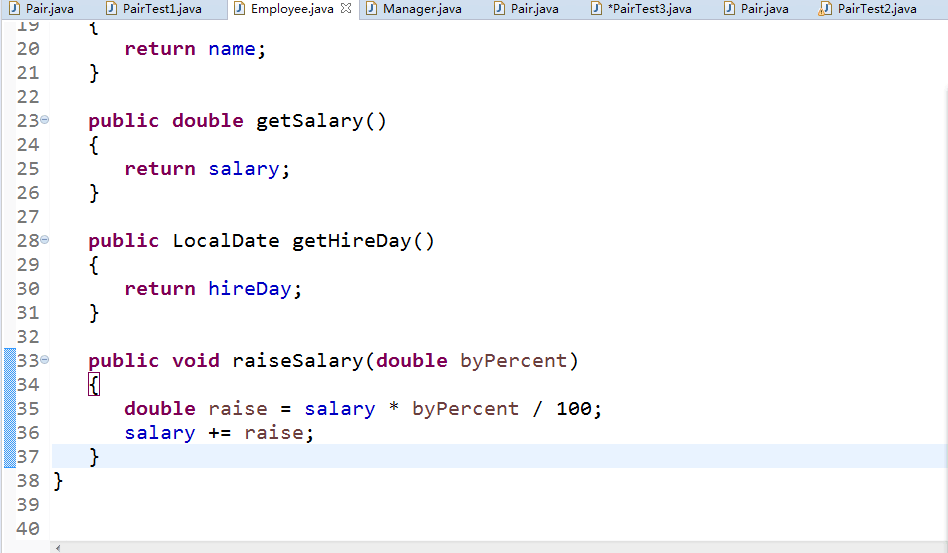

实验2:编程练习:
编程练习1:实验九编程题总结
l 实验九编程练习1总结(从程序总体结构说明、目前程序设计存在的困难与问题三个方面阐述)。
程序总体结构:主类PairTest1和Pair<T>类
目前程序设计存在的困难与问题:
偶尔会存在读文件时,文件路径不正确,无法找到文件的问题,还有会读文件,但是就是自己编写有问题,要不就得百度,要不就查书,检查问题的。
l 实验九编程练习2总结(从程序总体结构说明、目前程序设计存在的困难与问题三个方面阐述)。
程序总体结构:主类PairTest2和Pair<T>类:
目前程序设计存在的困难与问题:
读代码问题不大,但还是存在编写程序的问题,我会通过多加练习慢慢提高。
编程练习2:采用泛型程序设计技术改进实验九编程练习2,使之可处理实数四则运算,其他要求不变。
1 import java.io.FileNotFoundException; 2 import java.io.IOException; 3 import java.io.PrintWriter; 4 import java.util.Scanner; 5 public class Fine { 6 7 public static void main(String[] args) { 8 Scanner in = new Scanner(System.in); 9 Min min=new Min(); 10 PrintWriter out = null; 11 try { 12 out = new PrintWriter("test.txt"); 13 int sum = 0; 14 for (int i = 1; i <=10; i++) { 15 int a = (int) Math.round(Math.random() * 100); 16 int b = (int) Math.round(Math.random() * 100); 17 int menu = (int) Math.round(Math.random() * 3); 18 switch (menu) { 19 case 0: 20 System.out.println(i+":"+a + "+" + b + "="); 21 int c1 = in.nextInt(); 22 out.println(a + "+" + b + "=" + c1); 23 if (c1 == (a + b)) { 24 sum += 10; 25 System.out.println("恭喜答案正确"); 26 } else { 27 System.out.println("抱歉,答案错误"); 28 } 29 break; 30 case 1: 31 while (a < b) { 32 b = (int) Math.round(Math.random() * 100); 33 } 34 System.out.println(i+":"+a + "-" + b + "="); 35 int c2 = in.nextInt(); 36 out.println(a + "-" + b + "=" + c2); 37 if (c2 == (a - b)) { 38 sum += 10; 39 System.out.println("恭喜答案正确"); 40 } else { 41 System.out.println("抱歉,答案错误"); 42 } 43 44 break; 45 case 2: 46 System.out.println(i+":"+a + "*" + b + "="); 47 int c3 = in.nextInt(); 48 out.println(a + "*" + b + "=" + c3); 49 if (c3 == a * b) { 50 sum += 10; 51 System.out.println("恭喜答案正确"); 52 } else { 53 System.out.println("抱歉,答案错误"); 54 } 55 56 break; 57 case 3: 58 while(b == 0){ 59 b = (int) Math.round(Math.random() * 100); 60 } 61 while(a % b != 0){ 62 a = (int) Math.round(Math.random() * 100); 63 64 } 65 System.out.println(i+":"+a + "/" + b + "="); 66 int c4 = in.nextInt(); 67 if (c4 == a / b) { 68 sum += 10; 69 System.out.println("恭喜,答案正确"); 70 } else { 71 System.out.println("抱歉,答案错误"); 72 } 73 74 break; 75 } 76 } 77 System.out.println("你的得分为" + sum); 78 out.println("你的得分为" + sum); 79 out.close(); 80 } catch (FileNotFoundException e) { 81 e.printStackTrace(); 82 } 83 } 84 }
1 public class Min<T> { 2 private T a; 3 private T b; 4 public Min() { 5 a=null; 6 b=null; 7 } 8 public Min(T a,T b) { 9 this.a=a; 10 this.b=b; 11 } 12 public int count1(int a,int b) { 13 return a+b; 14 } 15 public int count2(int a,int b) { 16 return a-b; 17 } 18 public int count3(int a,int b) { 19 return a*b; 20 } 21 public int count4(int a,int b) { 22 return a/b; 23 } 24 }


